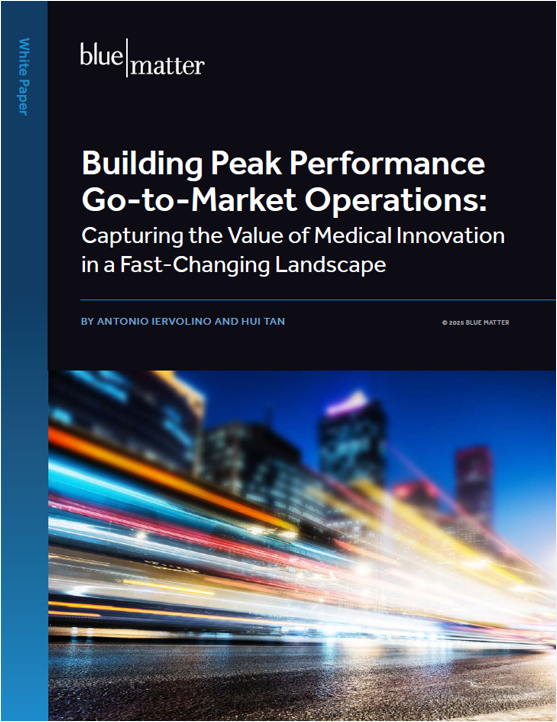
For any company, a new product launch is a big deal. For an emerging biopharma company, the decision to launch a first product is a really big deal that sets in motion organizational transformation and a wide range of launch readiness activities.
A biopharma company launching its first product will have significant investments over the 3 years leading up to launch across all of the functions involved (including beyond Commercial). This is a significant investment (for example, ~$100-200m for a novel oncology therapeutic) and can often lead to sticker shock as leadership teams (and finance teams) seek to understand what parts of the launch truly warrant investment.
Sometimes, emerging companies will miss the mark: they may think like “Big Pharma” and pour more resources into the launch than is warranted. Alternatively, they may try to minimize investment and end up missing something critical. How can a company find that just-right “Goldilocks” approach?
We often see companies look for potential analogs to understand the required investment, but we strongly caution against leaning too much on analogs. A range of factors can affect the level of investment needed, such that no two situations are directly comparable. Below, we offer some guidance to help companies think through “right-sizing” a launch for their specific situations.
Key Factors That Can Affect the Required Investment
In part 4 of this series, we discussed the importance of knowing what it would take to commercialize a product, even if the ultimate goal was to out-license it. While we won’t revisit everything covered in that article, there are several key product- or market-specific factors that can have a direct impact on the level of investment required to launch an asset, summarized in Table 1:
Table 1 – A Non-Exhaustive List Of Product- or Market-Specific Factors Impacting the Level of Investment Needed for First Launch
| Market Factors | Target patient population size and concentration | Smaller patient populations may require up-front investment to appropriately find and target, whereas larger patient populations may require more investment overall to reach a broader set of patients. Since the size of the patient population is correlated with the potential market opportunity, it often impacts a company’s willingness to invest. However, the concentration of patients can drastically impact required investment. Patient populations that are heavily concentrated at a few key prescribers / accounts - or even alternate channels such as advocacy groups or social media - may need only a focused investment to capture. |
| HCP types and concentration | The diversity and types of HCPs involved in the patient journey can impact the required investment. For example, engaging multiple stakeholders that are involved in diagnosis (such as in rare diseases) or a treatment decision (such as surgeons, medical oncologists, and radiation oncologists for many non-metastatic tumor types) will require more investment than targeting a single clear decision-maker. Furthermore, different HCP types may have different education needs - e.g., educating oncologists in academic medical centers on a novel MOA may require less effort than a community oncologist who isn’t as close to clinical research. Similar to the patient landscape, target prescribers that are more concentrated at specific accounts or other channels (e.g., congresses) may be reached with more focused investment. |
|
| Disease awareness / understanding | If awareness or understanding of the disease is low, then additional investments will be needed to educate patients, physicians, and other stakeholders. | |
| Unmet need | If there isn’t a clear and impactful unmet need that the product addresses, a company will need to invest in market-shaping to create the demand for its product. | |
| Near-term competition | Competition always drives up the investment required, as the company will need to invest to differentiate - especially since competitors will not remain static and will actively work against the newcomer. | |
| Patient access & affordability | Multiple potential factors can impact access and affordability and signal the need for greater investment, including: |
|
| Product Factors | Novelty of the mechanism of action (MOA) | A highly novel MOA might be a strong differentiator, but it can also drive up the investments required to educate stakeholders. |
| Clinical differentiation | If the product isn’t meaningfully differentiated from the current standard of care and/or near-term competitive entrants, the company will need to spend more to differentiate the therapy and drive adoption. | |
| Future lifecycle | Does the company plan to launch more indications over the product’s commercial lifecycle, or other products in the portfolio? If so, the total market opportunity will increase, which may warrant additional investment in the first launch to set the foundation for long-term success across indications. |
How These Factors Impact Investment
Before considering a list of activities that require investment, it’s important to clarify what we must achieve for the launch to be successful. We will refer to these as our launch objectives. A company’s launch objectives should be informed by a strong understanding of the situation and factors that will help or hinder the success of the launch including, but not limited to, some of the factors listed above.
Many launches have objectives related to the themes summarized in Table 2:
Table 2 – Typical Themes for Launch Objectives
| Market Shaping | Market shaping is intended to influence, transform, or build a market to make it easier for patients, physicians, and other stakeholders to adopt or access a therapy. Situations that might require greater investment in market shaping include: |
| Differentiation | Differentiation is a critical objective for just about any product in any market to help a customer choose a product instead of alternate options, even when that alternate option is “do nothing”! Situations that might require greater investment in differentiation include: |
| Reach & Share of Voice (SOV) | Reaching target stakeholders, getting the optimum “share of voice” in the marketplace, and earning the right amount of mindshare among target stakeholders is essential to product adoption. Situations that might require greater investment in reach and share of voice include: |
| Access | Access and reimbursement is critical to the success of nearly every therapy, so some investment here will always be needed. Situations that might require greater investment in access & reimbursement include: |
| Customer Experience | At minimum, providing a great experience can help ensure that customers don’t walk away from your product because of one negative experience. At best, a truly elevated customer experience can be a strong differentiator beyond a product’s clinical profile. Situations that might require greater investment in customer experience include: |
Once a company defines launch objectives, it is easier to determine where and how to invest in specific activities. Typically, a few of the areas with the highest spend (multiple millions of dollars) and most variable spend include:
- Evidence Generation: Though critical to supporting differentiation and access, generating data through investigator-sponsored trials, real-world evidence, further analysis on registrational trials, and more can be highly resource-intensive, requiring companies to thoughtfully invest in the highest-priority studies.
- Insights Gathering (Incl. Secondary Data): Since insights inform launch strategy and almost every other launch activity, it is easy for research and analytics budgets to balloon, requiring companies to determine which insights are truly critical to make decisions and move forward.
- Marketing: The sky is the limit for how much a company can possibly spend on developing and deploying campaigns, so companies need to avoid swirling in the creative concept and design process and need to be highly selective in choosing the right channels and tactics to engage their different customer types.
- Customer-Facing Teams / Field Force: While critical for customer engagement, customer-facing teams can account for half or more of the entire commercial team headcount, requiring companies to carefully design roles / responsibilities and deployment strategy to get the right return on investment.
- IT (Systems & Platforms): The sheer number of systems that a company needs to build new or update is daunting, requiring companies to think critically about the business and technical requirements for each system, and which can be built simply in-house vs. bought “off the shelf” vs. being customized.
Each of these areas of variable spend can support most or all of the typical launch themes mentioned above.
As a brief aside, one common misconception we encounter is when executive leadership teams ask to delineate between “must have” and “nice to have” activities in a launch roadmap. In actuality, almost every activity is a “must-have” at some level, and the real question is how much to invest in that activity. For example, every product needs a website. Even if a company doesn’t want to broadly promote a product, they must still provide a basic website with product and company information in order to make the product available.
Relatedly, many activities have a fixed cost of time and/or budget to complete them. For example, establishing revenue recognition processes and gross-to-net calculations are requirements for any company that wants to commercialize a product. Investing in these activities is just the cost of doing business.
Considerations For Post-Approval
It’s important to note that we have focused on investments leading up to approval (i.e., the “build phase” in preparation for launch). Post-approval in the “execution phase”, the mix and magnitude of investments may shift, even if the overall launch objectives remain the same. For example, Marketing spend might decrease since the focus is on tweaking execution instead of building from scratch, while the investment in customer-facing teams can appear larger since a company needs to account for annualized headcount instead of only a few months of FTE in the couple of months ramping up to launch. Additionally, new potential cost centers – such as discounts and rebates for payers and distributors, or costs for patient support programs – will only be incurred once the product is on the market.
Parting Thoughts
As we can see, accurately right-sizing investment requires a thoughtful approach of:
- Building a strong understanding of the situation
- Developing a clear understanding of launch objectives (what we must achieve for launch to be successful), as well as any strategic trade-offs the company is willing to make
- Clarifying implications to investment in key activities with high and variable spend
Given the many potential factors involved, each company should be thoughtful about what is unique to their market, product, and organization and be careful of over-relying on industry analogs or past experiences of team members.
One final risk of not right-sizing the launch–and particularly the size of the organization–is inhibiting the efficiency and/or effectiveness of the launch team. In the next article, we’ll focus on why a company needs to devise new ways of working once it has made the decision to build commercial capabilities, and some of the challenges that may arise if the team isn’t right-sized at the start. Stay tuned…






